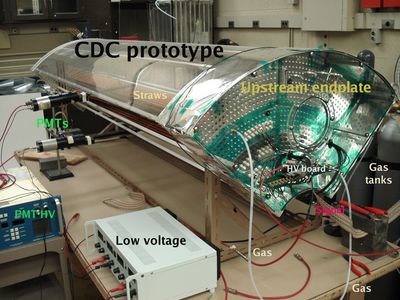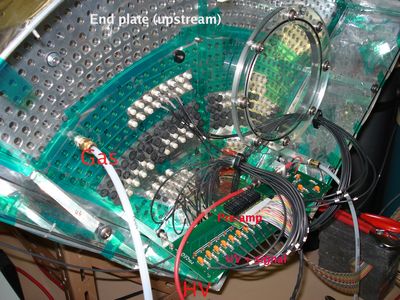Difference between revisions of "CDC"
(→Status Report on the CDC from 14 November 2007) |
|||
| Line 1: | Line 1: | ||
| + | == The GlueX Central Drift Chamber == | ||
| + | |||
| + | The CDC is a straw tube chamber that sits around the target in the | ||
| + | GlueX experiment. The straws nominally run parallel to the beamline | ||
| + | with readout on the upstream end of the chamber. About 30% of the straws | ||
| + | are tilted with a 6 degree stereo angle to provide a measurement of the | ||
| + | z position in two regions along the track. Tracks going more forward than | ||
| + | about 30 degrees will also be tracked by the forward drift chamber system | ||
| + | in the GlueX detector ([[ FDC ]]). | ||
| + | |||
| + | The 1.6cm diameter straws are arranged in 25 radial layers. The inner-most | ||
| + | layer is at about 10cm and the outermost is at about 58cm from the beamline. | ||
| + | The chamber is anticipated to achieve a 150 micron position resolution in | ||
| + | the r-phi plane, which when conbined with the stereo information will yield | ||
| + | a number of z measurements with resolution of about a mm. | ||
| + | |||
| + | The most up-to-date description of the CDC is found in GlueX-document 737 | ||
| + | which can be found on the portal http://portal.gluex.org . There were also | ||
| + | changes to this design that have been documents in GlueX-doc 744 and in | ||
| + | document number 764 is the budget justification information for the chamber. | ||
| + | All older documents should be considered out of date and probably inaccurate. | ||
| + | |||
| + | The CDC is being built by the Medium Energy Physics group at Carnegie Mellon | ||
| + | University http://www.cmu.edu . The current members of the CMU group involved in | ||
| + | this effort are: | ||
| + | |||
| + | |||
| + | |||
==Status Report on the CDC from 14 November 2007== | ==Status Report on the CDC from 14 November 2007== | ||
Since last week, we have mounted the chamber electronics on the outside of the chamber. We have also shifted the readout | Since last week, we have mounted the chamber electronics on the outside of the chamber. We have also shifted the readout | ||
Revision as of 15:53, 20 November 2007
The GlueX Central Drift Chamber
The CDC is a straw tube chamber that sits around the target in the GlueX experiment. The straws nominally run parallel to the beamline with readout on the upstream end of the chamber. About 30% of the straws are tilted with a 6 degree stereo angle to provide a measurement of the z position in two regions along the track. Tracks going more forward than about 30 degrees will also be tracked by the forward drift chamber system in the GlueX detector ( FDC ).
The 1.6cm diameter straws are arranged in 25 radial layers. The inner-most layer is at about 10cm and the outermost is at about 58cm from the beamline. The chamber is anticipated to achieve a 150 micron position resolution in the r-phi plane, which when conbined with the stereo information will yield a number of z measurements with resolution of about a mm.
The most up-to-date description of the CDC is found in GlueX-document 737 which can be found on the portal http://portal.gluex.org . There were also changes to this design that have been documents in GlueX-doc 744 and in document number 764 is the budget justification information for the chamber. All older documents should be considered out of date and probably inaccurate.
The CDC is being built by the Medium Energy Physics group at Carnegie Mellon University http://www.cmu.edu . The current members of the CMU group involved in this effort are:
Status Report on the CDC from 14 November 2007
Since last week, we have mounted the chamber electronics on the outside of the chamber. We have also shifted the readout to only readout straight layers at this point in time. This will allow us to get a better handle on the chamber resolution using the 16 channels of readout that are available in the two Flash ADC units at CMU.
We have also carried out new GARFIELD calculations of the electrostatics of the chamber. We include here a field line plot ( File:GARFIELD FIELDLINES.PS ) for the current voltage and gas mixture as well as a time-to-distance relation ( File:GARFIELD-XTPLOT.PS ) which we use to convert the drift times to a distance from the wire.
Finally, Yves has started to implement a simple track finder based on the ideas of a Hough transform of the data. We are currently at the point where we need to write the track fitting algorithm which will allow us to start to extract resolution numbers from the chamber. This is based on the idea that the individual hits are represented as a small circle where we know the center (x,y) and radius r. The track needs to be tangent to all of the measured circles.

